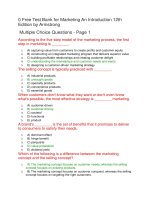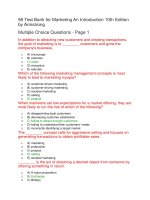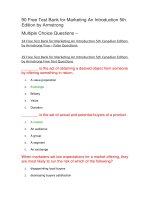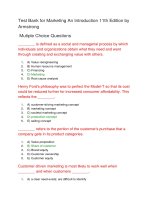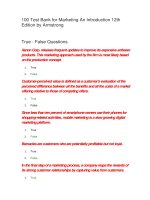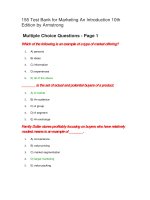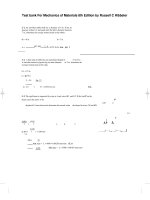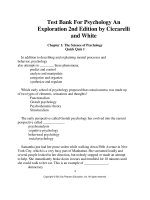Link download test bank for psychology an exploration 2nd edition by ciccarelli white
Bạn đang xem bản rút gọn của tài liệu. Xem và tải ngay bản đầy đủ của tài liệu tại đây (1.03 MB, 108 trang )
Test Bank For Psychology An
Exploration 2nd Edition by Ciccarelli
and White
Chapter 1: The Science of Psychology
Quick Quiz 1
In addition to describing and explaining mental processes and
behavior, psychology
also attempts to ________ these phenomena.
predict and control
analyze and manipulate
categorize and organize
synthesize and regulate
Which early school of psychology proposed that consciousness was made up
of two types of elements, sensations and thoughts?
Functionalism
Gestalt psychology
Psychodynamic theory
Structuralism
The early perspective called Gestalt psychology has evolved into the current
perspective called ____________.
psychoanalysis
cognitive psychology
behavioral psychology
social psychology
Samantha just had her purse stolen while walking down Fifth Avenue in New
York City, which is a very busy part of Manhattan. She screamed loudly and
several people looked in her direction, but nobody stopped or made an attempt
to help. She immediately broke down in tears and trembled for 10 minutes until
she could walk to her car. This is an example of ______________.
democracy
4
Copyright © 2013 by Pearson Education, Inc. All rights reserved.
the bystander effect
diffusion of effects
flaws in the judicial system
Sandi is a single mother living in a project in a poor section of the city. She
has addiction issues and just lost custody of her three children. What type of
professional is most likely to get involved in Sandi’s situation?
educational psychologist
psychiatrist
psychiatric social worker
counselor
The tendency to look for information that supports one’s own belief is called
___________.
the principle of falsifiability
confirmation bias
criterion validity
volunteer bias
In preparation for his master’s thesis, Tan spends some time in the local mall
observing the behavior of shoppers. His notes reveal a tendency for people to
smile when someone, even a stranger, smiles at them. Later in the semester, he
designs a questionnaire that asks questions of participants concerning their typical
reactions when someone smiles. He wonders if the face of a person who smiles has
any influence on returned smiles, so he designs a study to answer this question.
Which of the following lists in order, from first to last, the research methods Tan
has used?
experiment, case study, survey
case study, survey, experiment
correlation, case study, experiment
naturalistic observation, survey, experiment
A correlation coefficient represents two things: _____________ and
______________.
a representative sample; strength
strength; direction of the relationship
the experimental group; control group
direction of the relationship; expectant functionality
5
Copyright © 2013 by Pearson Education, Inc. All rights reserved.
Independent variable is to dependent variable as ________.
effect is to confound
experimental is to correlation
measure is to manipulate
manipulate is to measure
Two groups of graduate students were given rats and were told to teach them
how to run mazes. Group 1 was told that they had “very smart” rats that should
learn quickly. Group 2 was told that they had “very stupid” rats that should learn
slowly. In actuality, neither group was any different and the rats were randomly
assigned. In spite of that, when the experiment concluded, Group 1 rats had
learned the maze much more quickly. How can that be explained?
experimenter effect
placebo effect
subject bias
treatment effect
Chapter 1
Quick Quiz 1 Answers
1. Answer: a
Diff: 1
LO: 1.1 Page(s): 5
Type: Conceptual
2. Answer: d
Diff: 2
LO: 1.2 Page(s): 6
Type: Conceptual
3. Answer: b
LO: 1.3 Page(s): 9
Type: Factual
4. Answer: b
LO: 1.4 Page(s): 14
Type: Applied Diff: 2
5. Answer: c
LO: 1.5 Page(s): 16
Type: Applied Diff: 2
6. Answer: b
LO: 1.6 Page(s): 18
Type: Factual
7. Answer: d
Diff: 3
LO: 1.7 Page(s): 20-26
Diff: 1
Diff: 1
Type: Applied
6
Copyright © 2013 by Pearson Education, Inc. All rights reserved.
8. Answer: b
LO: 1.9 Page(s): 23
Type: Factual
Diff: 3
9. Answer: d
Diff: 2
LO: 1.10 Page(s): 26
Type: Conceptual
10. Answer: a
LO: 1.11 Page(s): 28
Type: Applied Diff: 2
7
Copyright © 2013 by Pearson Education, Inc. All rights reserved.
1 The Science of Psychology
Main Test Bank Questions
Key: Answer, Page, Type, Learning Objective, Level
Type
A=Applied
C=Conceptual
F=Factual
Level
(1)=Easy; (2)=Moderate; (3)=Difficult
LO=Learning Objective
SG=Used in Study Guide
p=page
MULTIPLE CHOICE
What Is Psychology?
Learning Objective 1.1 - What defines psychology as a field of study, and what
are psychology’s four primary goals?
Which of these is the most accurate definition of the discipline of psychology?
the scientific study of behavior
the scientific study of mental processes
the scientific study of behavior and mental processes
Correct. The definition of psychology includes both behavior and mental
processes and
does not exclude animals.
d) the scientific study of human behavior and mental processes
Incorrect. The definition of psychology also includes animal behavior and mental
processes.
ANS: c, p. 4, F, LO=1.1, (1) SG
% correct 45 a= 2 b= 1 c= 45 d= 53
r = .29
In the definition of psychology, the term mental processes refers to _________ .
internal, covert processes
8
Copyright © 2013 by Pearson Education, Inc. All rights reserved.
Correct. Mental processes are internal.
outward behavior
overt actions and reactions
Incorrect. Overt means outward, not internal.
only animal behavior
ANS: a, p. 4, F, LO=1.1, (1)
You are at a basketball game and the arena is packed; the crowd is evenly split
between fans of the two teams. At one point, the referee makes a call. Half of the
fans yell insults; the other half of the fans shout their approval. The event
reminds you of the topic of today’s lecture in psychology class. What was the
likely topic of the lecture?
bias
Correct. The fans are showing bias and this is an important issue.
b) experiments
Incorrect. The fans are really not part of any treatment groups.
psychoanalysis
extraneous variables
ANS: a, p 4, A, LO=1.1, (2)
Steve is a fan of the Los Angeles Lakers basketball team. With little
provocation, he will engage you in a debate about whether it is the greatest team
in basketball. Steve may be demonstrating ________________.
bias
Correct. Steve’s loyalty to his team will influence his debate.
b) critical thinking
an eclectic approach
unconscious behavior
ANS: a, p. 4, A, LO=1.1, (2)
A teacher tells the school psychologist that Kate is late to class, does not turn in
her homework, squirms around a lot in her seat, and swings her feet
constantly. This is an example of which goal of psychology?
a) describing behavior
Correct. We only know WHAT she is doing.
b) explaining behavior
Incorrect. Explaining focuses on why it is happening, not what is
happening. c) predicting behavior
9
Copyright © 2013 by Pearson Education, Inc. All rights reserved.
controlling behavior
ANS: a, p. 2, A, LO=1.1, (2)
% correct 85 a= 85 b= 14 c= 0 d= 0
r = .34
6. The question “What is happening?” refers to which of the following goals
in psychology?
a) description
Correct. Asking “what” means asking for a description.
b) explanation
Incorrect. Explanation goes beyond “what.”
prediction
control
ANS: a, p. 4, F, LO=1.1, (1)
% correct 28 a= 28 b= 58 c= 11 d= 2
r = .26
The goals of psychology are to ___________.
explore the conscious and unconscious functions of the human mind
understand, compare, and analyze human behavior
improve psychological well-being in all individuals from birth
until death
describe, explain, predict, and control behavior
Correct. These adequately help uncover the mysteries of behavior.
ANS: d, pp. 4-5, F, LO=1.1, (1)
% correct 40
a= 17 b=39 c= 3 d= 40
r = .35
% correct 96
a= 4 b= 0 c= 0 d= 96
r = .54
8. The question “Why is it happening?” refers to which of the following goals
in psychology?
a) description
Incorrect. Describing does not answer the question why.
b) explanation
Correct. Asking “Why?” calls for an explanation.
prediction
control
ANS: b, pp. 4-5, F, LO=1.1, (1)
A psychologist is interested in finding out why identical twins have different
personalities. This psychologist is most interested in the goal of ____________.
10
Copyright © 2013 by Pearson Education, Inc. All rights reserved.
a) description
Incorrect. “Why” does not describe; it explains.
b) explanation
Correct. “Why” asks for an explanation.
prediction
control
ANS: b, pp.4-5, F, LO=1.1, (1)
The goals of psychology are to _________.
explore the conscious and unconscious functions of the human mind
understand, compare, and analyze human behavior
improve psychological well-being in all individuals from birth
until death
describe, explain, predict, and control behavior
Correct. These adequately help uncover the mysteries of behavior.
ANS: d, pp. 4-5 F, LO=1.1, (1)
% correct 40
a= 17 b=39 c= 3 d= 40 r = .35
% correct 96
a= 4 b= 0 c= 0 d= 96 r = .54
Mei was sent to the school psychologist to be tested. Based on her IQ scores it
was decided that she would do well in the gifted child program. This is an
example of which goal of psychology?
describing behavior
explaining behavior
Incorrect. Explaining focuses on why it is happening.
c) predicting behavior
Correct. Mei’s score served as a predictor (“would do well”) of performance.
controlling behavior
ANS: c, p. 5, A, LO=1.1, (2)
% correct 76 a= 8 b= 7 c= 76 d= 9
r = .20
12. The question “When will it happen again?” refers to which of the following
goals in psychology?
description
explanation
Incorrect. Explanation deals with the present.
c) prediction
Correct. Prediction deals with future events.
11
Copyright © 2013 by Pearson Education, Inc. All rights reserved.
d) control
ANS: c, p. 5, F, LO=1.1, (1)
% correct 92 a= 0 b= 4 c= 92 d= 4
r = .36
In addition to describing and explaining mental processes and
behavior, psychology
also attempts to ________ these phenomena.
predict and control
analyze and manipulate
categorize and organize
Incorrect. These are not mentioned by your authors as being goals of psychology.
synthesize and regulate
ANS: a, p. 5, C, LO=1.1, (1)
% correct 89 a= 7 b= 89 c= 3 d= 2
r = .29
14. The question “How can it be changed?” refers to which of the following
goals in psychology?
description
explanation
prediction
Incorrect. Prediction does not cause change.
d) control
Correct. Control modifies behavior.
ANS: d, p. 5, F, LO=1.1, (1)
Psychologists who give potential employees tests that determine the kinds of
jobs at which those employees might perform best are interested in the goal of
_____________.
description
explanation
Incorrect. The test is predicting, not explaining.
c) prediction
Correct. The test predicts behavior.
d) control
ANS: c, p. 5, A, LO=1.1, (2)
% correct 83 a= 7 b=41 c= 83 d= 7
r = .29
16. Description is to assessment as __________ is to prognosis.
12
Copyright © 2013 by Pearson Education, Inc. All rights reserved.
a) prediction
Correct. A prognosis is a prediction of what will happen.
b) explanation
Incorrect. An explanation does not indicate future outcomes.
indication
control
ANS: a, p. 5, C, LO=1.1, (3)
Psychology Then: The History of Psychology
Learning Objective 1.2 - How did structuralism and functionalism differ, and
who were the important people in those early fields?
In 1879, in Leipzig, Germany, the first psychological laboratory was
developed by ______________.
William James
William Tell
Wilhelm Wundt
Correct. Wundt established the first psychological laboratory.
d) Sigmund Freud
Incorrect. Freud’s theory came later, and he had no lab.
ANS: c, p. 6, F, LO=1.2, (1)
% correct 88
a= 7 b= 1 c= 88 d= 4
r = .23
% correct 100 a= 0 b= 0 c= 100 d= 0
r = .00
At the close of the nineteenth century, Gerhard is excited to find that he has
been accepted for training in the psychology laboratory of Wilhelm Wundt. It
is likely that Gerhard will be trained to ________________.
analyze how to break down his sensations into their most basic elements
Correct. Wundt was a structuralist.
determine the function or purpose of a particular human
behavior Incorrect. Wundt was not a functionalist.
listen intently while individuals tell him of their depression or
nervousness
carefully feel the bumps on a person’s head in order to determine his
or her character traits
ANS: a, p. 6, A, LO=1.2, (2)
The school of psychology called structuralism used a technique called
13
Copyright © 2013 by Pearson Education, Inc. All rights reserved.
_________, which involved reporting the contents of consciousness to study
a person’s experiences.
a) intervention
Incorrect. Intervention has a totally different meaning than introspection,
even though it looks similar.
b) introspection
Correct. This requires self-examination of the structure of the mind.
c) insight inventory
d) induction
ANS: b, p. 6, F, LO=1.2, (2) SG
% correct 96 a= 0 b= 96 c= 4 d= 0
r = .24
ЀĀ
ȀĀ⤀Ā ᜀ
Ā ᜀ
hich early school of psychology proposed that consciousness was made up of two
types of elements, sensations and thoughts?
a) Functionalism
Incorrect. Functionalism focused on the purpose of consciousness, not dissecting it
into its basic elements.
Gestalt psychology
Psychodynamic theory
Structuralism
Correct. These two elements comprise the way that structuralism characterized
human consciousness.
ANS: d, p. 6, C, LO=1.2, (2)
Objective introspection requires
metaphysical experiences.
self-skepticism about experiences.
empiricism.
Incorrect. Empiricism refers to using collected data to support a hypothesis. It
is not related to the concept of introspection.
d) examining one’s own thoughts and mental activities.
Correct. Remember that introspection literally means "looking within."
ANS: d, p. 6, F, LO=1.2, (1)
22. Participants in research early in psychology’s history might have been asked to
view a chair and describe its color, shape, and texture and other aspects of their
conscious experience. These individuals would have been using a method called
_________.
a) hypnosis
14
Copyright © 2013 by Pearson Education, Inc. All rights reserved.
Ā ᜀ
b) objective introspection
Correct. In introspection you describe your conscious thoughts.
psychosurgery
psychoanalysis
Incorrect. Psychoanalysis was not concerned with these issues.
ANS: b, p. 6, C, LO=1.2, (2)
Why was the perspective followed by Wilhelm Wundt and his followers
called structuralism?
ЀĀ
ȀĀ⤀Ā ᜀ
Ā ᜀ
hey wanted to identify the major brain structures.
ЀĀ
ȀĀ⤀Ā ᜀ
Ā ᜀ
heir primary goal was to understand the physiology of the mind.
Incorrect. It was the structure of thought, not physiology.
ЀĀ
ȀĀ⤀Ā ᜀ
Ā ᜀ
hey focused their efforts on analyzing the elements of the nervous
system.
ЀĀ
ȀĀ⤀Ā ᜀ
Ā ᜀ
heir primary focus was on describing the structure of conscious
experience.
Correct. Structure was key in the definition.
ANS: d, p. 6, F, LO=1.2, (1)
% correct 48 a= 30 b= 19 c= 4 d= 48
r = .18
24. The structuralists were important in the history of psychology because
they a) examined consciousness and the structure of mental processes.
Correct. The structuralists were interested in understanding the basic structure
of human consciousness.
were the first to use brain-scanning techniques to learn about the structure
of the brain.
realized the limits of introspection and focused on the structure of
behaviors.
were strongly influenced by Charles Darwin.
Incorrect. This would be a statement applicable to the functionalists, not
the structuralists.
ANS: a, p. 6, C, LO=1.2, (2)
What is the best analogy for Wundt’s and Titchener’s mission for psychology?
a chart listing the basic chemical elements
Correct. They wanted to break down the mind into basic elements.
a list of the courses required for graduation
a list of the types of clothing sold at a retail outlet
a computer program for word processing a term paper
Ā
Ā
Ā
Ā
15
Copyright © 2013 by Pearson Education, Inc. All rights reserved.
Incorrect. A computer program does not have basic elements.
ANS: a, p. 6, C, LO=1.2, (3)
Who was an early proponent of functionalism?
Ivan Pavlov
William James
Correct. James was a functionalist.
c) Wilhelm Wundt
Incorrect. Wundt was a structuralist.
Max Wertheimer
ANS: b, p. 7, F, LO=1.2, (1)
% correct 100 a= 0 b= 100 c= 0 d= 0
r = .00
How our minds help us adapt to the world around us was a primary question
addressed by which early movement of psychology?
Behaviorism
Cognitivism
Functionalism
Correct. The functionalists were interested in determining the purpose of human
consciousness, or how it helped us with our everyday lives.
d) Structuralism
Incorrect. The structuralists were interested in determining the structure, or
basic makeup, of human consciousness.
ANS: c, p. 7, F, LO=1.2, (1)
If an individual believed that why people think and feel as they do is
more important than what they think and how they think, that individual
would be a proponent of the _________ approach to psychology.
structuralist
Incorrect. The structuralists were interested in determining the structure, or
basic makeup, of human consciousness.
b) functionalist
Correct. The functionalists were interested in determining the purpose of human
consciousness, or how it helped us with our everyday lives.
psychodynamic
behaviorist
ANS: b, p. 7, C LO=1.2, (2)
29. Which of the following terms belong together?
16
Copyright © 2013 by Pearson Education, Inc. All rights reserved.
structuralism; observable behavior
Gestalt; separate parts
psychoanalysis; conscious conflict
Incorrect. These terms do not belong together.
natural selection; functionalism
Correct. Natural selection and functionalism do belong together because both are
related to adaptation.
ANS: d, p. 7 , C, LO=1.2-1.3, (3)
Which of the following women became the first female president of
the American Psychological Association in 1905?
Ruth Howard
Mary Whiton Calkins
Correct. Mary Whiton Calkins was the first female president of the American
Psychological Association.
Anna Freud
Mamie Clark
Incorrect. Mary Whiton Calkins was the first female president of the American
Psychological Association.
ANS: b, p 7, F, LO=1.2, (1)
Which psychologist was the first African American to receive a Ph.D.
in educational psychology from the University of Chicago in 1925?
a) Charles Henry Thompson
Correct. Charles Henry Thompson was the first African American to receive a
Ph.D. in educational psychology from the University of Chicago.
Linus Pauling
Albert Sidney Beckham
Incorrect. Albert Sidney Beckham received his Ph.D. in psychology in 1930
from New York University.
Inez Beverly Prosser
ANS: a, p. 7, F, LO=1.2, (1)
If a functionalist from the 1870s were alive today, where would we most
likely find him?
in a laboratory, studying principles of perception
in a school, working to improve teaching methods
Correct. Functionalists applied research.
c) in a mountain retreat, contemplating the meaning of life
17
Copyright © 2013 by Pearson Education, Inc. All rights reserved.
in a sleep laboratory, trying to determine if our need for sleep
is biologically based
Incorrect. This would be considered pure research.
ANS: b, p. 8, A, LO=1.2, (3)
ᜀ
Ā ᜀ
Ā ᜀ
hich noted African American psychologist held posts as president of Shaw
University in North Carolina and then as president of Virginia State College?
Charles Henry Thompson
Howard Hale Long
Incorrect. Howard Hale Long was Dean of Administration at Wilberforce
State College in Ohio.
c) Robert Prentiss Daniel
Correct. Robert Prentiss Daniel, a noted African American psychologist, was the
president of Shaw University and then Virginia State College.
Albert Sidney Beckham
ANS: c, p. 8, F, LO=1.2, (1)
While Margaret Floy Washburn may have been the first woman to receive a
Ph.D. in psychology in the United States (in 1894), the first African American
woman to do so was _________ in 1934 at the University of Minnesota.
Inez Beverly Prosser
Incorrect. Ruth Howard was the first African American woman to receive a Ph.D.
in psychology in the United States.
b) Ruth Howard
Correct. Ruth Howard was the first African American woman to receive a Ph.D.
in psychology in the United States.
Margaret Mahler
Anna Freud
ANS: b, p. 9, F, LO=1.2, (1)
Learning Objective 1.3 - What were the basic ideas and who were the important
people behind the early approaches known as Gestalt, psychoanalysis, and
behaviorism?
Which type of early psychologist believed that “the whole is greater than
the sum of its parts”?
a) Gestalt
Correct. The Gestalt psychologists studied the perception of wholes.
b) behaviorist
18
Copyright © 2013 by Pearson Education, Inc. All rights reserved.
Ā ᜀ
c) structuralist
Incorrect. Structuralists focused on the elements of consciousness.
d) functionalist
ANS: a, p. 9, F, LO=1.3, (2)
36. “The whole is greater than the sum of the parts” is a statement associated
with the perspective of ______________ .
introspection
functionalism
psychoanalysis
Incorrect. Psychoanalysis was concerned with unconsciousness, not
“wholes.” d) Gestalt psychologists
Correct. “The whole is greater than the sum of the parts” was the theme of
the Gestalt psychologists.
ANS: d, p. 9, F, LO=1.3, (1)
% correct 55 a= 14 b= 21 c= 11 d= 55
r = .43
While on a visit to a large city, you observe several billboards in which a
series of lights seems to move. Which perspective in psychology would most
likely help you understand this phenomenon?
Gestalt
Correct. Gestalt psychologists focused on perception of the whole.
behavioral
humanistic
psychodynamic
Incorrect. This theory focused on the unconscious.
ANS: a, p. 9, C, LO=1.3, (3)
Gestalt psychology attempted to discover
how the mind helped people adapt to the world.
the overall patterns of perceptions and thoughts.
Correct. Gestalt psychologists looked at larger wholes, rather than
individual parts.
c) the basic building blocks of consciousness.
Incorrect. This would be an emphasis of structuralists, not Gestalt psychologists.
the unconscious motivations for human functioning.
ANS: b, p. 9 , C, LO=1.3, (2)
19
Copyright © 2013 by Pearson Education, Inc. All rights reserved.
The early perspective called Gestalt psychology has evolved into the
current perspective called ____________.
psychoanalysis
cognitive psychology
Correct. Gestalt psychology is now part of cognitive psychology, which focuses
on perception as well as learning,
memory, and thought processes.
c) behavioral psychology
Incorrect. This area of psychology only focuses on observable behavior.
social psychology
ANS: b, p. 9, F, LO=1.3, (1)
40. The belief that the unconscious mind has an influence on one’s behavior is
part of what early field of psychology?
a) structuralism
Incorrect. Structuralism does not examine the unconscious.
functionalism
psychoanalysis
Correct. The unconscious is a major component of psychoanalysis.
d) behaviorism
ANS: c, p. 10, F, LO=1.3, (1)
% correct 56 a= 7 b= 9 c= 56 d= 27
r = .37
What did Sigmund Freud consider as the key to understanding the
nervous disorders he observed?
free will
brain physiology
Incorrect. There was no physical cause to the problems patients
had. c) the unconscious mind
Correct. Freud’s entire theory centered on the unconscious.
external consequences
ANS: c, p. 10, C, LO=1.3, (2)
The class is playing a game of Jeopardy! and it is your turn. “I'll take Pioneers
in Psychology for $50.” The revealed answer is “Focused on unconscious factors
and relied on the case study method.” Just before the buzzer sounds, what will you
say?
“Who is B. F. Skinner?”
Incorrect. Skinner rejected the unconscious.
20
Copyright © 2013 by Pearson Education, Inc. All rights reserved.
“Who are the humanists?”
“Who is Sigmund Freud?”
Correct. Freud based his entire theory on the unconscious and used the case study
method.
“Who are the behaviorists?”
ANS: c, p. 10, C, LO=1.3, (2)
% correct 81 a= 7 b= 0 c=81 d= 12 r = .19
Freud stressed the importance of _____________ on the formation
of personality.
a) early childhood experiences
Correct. Freud believed personality was formed in the first six years of
life. b) adolescence
Incorrect. Freud stressed the first six years.
early adulthood
middle adulthood
ANS: a, p. 10, F, LO=1.3, (2)
According to __________, nervous disorders arose in patients as a result
of their repressed unconscious urges trying to surface.
John Watson
B. F. Skinner
Incorrect. Skinner focused on learned behavior, not on the
unconscious. c) Sigmund Freud
Correct. Freud believed the unconscious influences behavior.
d) Ivan Pavlov
ANS: c, p. 10, F, LO=1.3, (2)
According to Freud, unconscious urges
are able to be suppressed.
only pertain to sex.
Incorrect. Freud also felt that unconscious urges were related to aggressive
impulses.
c) attempt to surface and affect our behaviors.
Correct. Freud believed that unconscious urges could not stay completely
unconscious indefinitely, and that they would be expressed in one way or another.
have no impact on everyday life.
ANS: c, p. 10, C, LO=1.3, (2)
21
Copyright © 2013 by Pearson Education, Inc. All rights reserved.
The work of Freud was built around _____________.
a theory of personality that emphasizes the awareness of one’s
own cognitive processes
b) a theory of personality that emphasizes unconscious motives and
conflicts Correct. Unconscious motives and conflicts are the essential elements of
psychoanalysis.
a method of psychotherapy in which an observer carefully records
and interprets behavior without
interfering with the behavior
Incorrect. Psychoanalysts do not necessarily refrain from directing behavior.
a method of psychotherapy that emphasizes how maladaptive
behaviors are learned through imitations of
others and through cognitive expectations
ANS: b, p. 10, F, LO=1.3, (3)
Which treatment approach did Sigmund Freud develop for treating his
patients?
drug therapy
neuropsychology
clinical psychology
Incorrect. This was not yet a discipline.
d) psychoanalysis
Correct. It fit with his assumptions about the mind.
ANS: d, p. 10, F, LO=1.3, (1)
The Russian physiologist Ivan Pavlov discovered that ______________.
dogs would salivate to the sound of a bell due to habituation
Incorrect. Conditioning, not habituation, is the correct answer.
dogs would salivate to the sounds of a bell due to reflexology
dogs would salivate to the sound of a bell due to a learned reflexive
response called conditioning
dogs would salivate to the sounds of a bell due to their fear response
ANS: c, pp. 10-11, F, LO=1.3, (2)
Sallie noticed that when her alarm clock goes off in the morning her dog, Ruffles,
is standing by her bed salivating. Every morning when Sallie wakes to the alarm,
she immediately rolls out of bed and feeds Ruffles who very much enjoys his
canned dog food. It is likely that _______________.
22
Copyright © 2013 by Pearson Education, Inc. All rights reserved.
Sallie has conditioned Ruffles to enjoy canned dog
food Incorrect. The correct answer is d.
Sallie has conditioned Ruffles to sleep next to her bed
Sallie has conditioned Ruffles to salivate over canned dog food
Sallie has conditioned Ruffles to salivate to the sound of her alarm clock
Correct. Ruffles has learned to associate the sound of the alarm clock with being
fed.
ANS: d, pp. 10-11, A, LO=1.3, (1)
50. Pavlov’s research demonstrated that ____________.
a) involuntary reaction (salivation) could occur in response to an
unrelated stimulus (sound of a bell)
Correct. This is true based on his research of conditioning.
b) an unrelated stimulus (salivation) could occur in response to an
involuntary reaction (sound of a bell)
Incorrect. This is not true as the involuntary reaction is salivation and the
unrelated stimulus is the sound of the bell.
c) involuntary reaction (sound of a bell) could occur in response to
an unrelated stimulus (food)
d) an unrelated stimulus (food) could occur in response to an
unrelated stimulus (barking)
ANS: a, pp. 10-11, F, LO=1.3, (3)
51. Which founding contributors to psychology helped develop behaviorism?
Gestalt and Wundt
Freud and Watson
Incorrect. Freud was a psychoanalyst.
c) Watson and Pavlov
Correct. They contributed to behaviorism.
d) Pavlov and Wundt
ANS: c, pp. 10-11 , C, LO=1.3, (2)
John B. Watson believed that psychology should involve the study of
___________.
behavior
the mind
the brain
consciousness
23
Copyright © 2013 by Pearson Education, Inc. All rights reserved.
Incorrect. This was not observable.
ANS: a, p. 11, F, LO=1.3, (1)
Ȁ ⤀Ā ᜀ
Ā ᜀ
hich school of psychology questioned whether psychologists should study the
mind?
Ā
Ȁ ⸀Ā ЀĀ
ȀĀ⤀Ā ᜀ
sychodynamic theory
Ā
Ȁ ⸀Ā ЀĀ
ȀĀ⤀Ā ᜀ
ehaviorism
Correct. Behaviorists believe that the science of psychology should focus only
on directly observable and measurable behaviors.
c) Gestalt psychology
Incorrect. Gestalt psychology did not object to studying the mind, but wanted
to study it as all whole rather than as a series of parts.
the cognitive revolution
ANS: b, p. 11, F, LO=1.3, (1)
The school of behaviorism attempted to explain behavior by studying
the reasons people give for their behaviors.
the specific personality traits that lead to behavior.
how a specific stimulus evokes a specific response.
Correct. This relationship, called a stimulus-response association, is one of the
major foundations of behaviorism.
d) the purposes of people’s behavior.
Incorrect. This would be the focus of functionalism, not behaviorism.
ANS: c, p. 11, C, LO=1.3, (2)
55. What advice might John B. Watson have offered to psychologists of his
time? a) “Focus on observable behavior.”
Correct. Behaviorism was founded on the study of observable
behavior. b) “Life is an effort to overcome inferiority.”
“We cannot know others until we know ourselves.”
Incorrect. Watson only studied what he observed.
“Remember that what we accomplish is due to the composition of
our genes.”
ANS: a, p. 11, A, LO=1.3, (1)
% correct 75 a= 75 b= 6 c= 14 d= 3
r = .38
Which type of psychologist would be most likely to argue that a criminal
engages in unlawful behavior because he grew up around older boys who
engaged in criminal activities?
24
Ā ᜀ
Copyright © 2013 by Pearson Education, Inc. All rights reserved.
a) A Gestalt
psychologist
b) A behaviorist
Correct. This theory focused on learned behavior.
c) A psychodynamic psychologist
Incorrect. This theory focused on unconscious influences.
d) A functionalist
ANS: b, p. 11, C, LO=1.3, (2)
Freud said phobias were ___________ whereas Watson said phobias were
___________.
learned; inherited
repressed conflicts; learned
Correct. Freud studied repressed conflict and Watson studied observable behavior.
c) sexual; unconscious
Incorrect. Watson did not believe in the unconscious.
conditioned; unconditioned
ANS: b, p. 11, F, LO=1.3, (2) SG
Which pair of scientists shared the most similar views of behavior?
William James and Wilhelm Wundt
Incorrect. One was a functionalist and the other was a structuralist.
B. F. Skinner and Max Wertheimer
Ivan Pavlov and John B. Watson
Carl Rogers and Edward Titchener
ANS: c, p. 11, C, LO=1.3, (3)
% correct 46 a= 31 b= 19 c= 46 d= 5
r = .28
Suppose you were a graduate student studying for a Ph.D. in psychology in
the 1920s. Your advisor was strongly influenced by John B. Watson. Which of the
following might your advisor consider an acceptable choice for your research?
a survey of daydreams
an analysis of how specific behaviors are acquired
Correct. Watson believed observable behavior should be the focus of study.
a survey of sexual imagery in dreams of men and women
an analysis of the thought processes students report while answering test
items
Incorrect. You cannot observe thought processes.
ANS: b, p. 11, A, LO=1.3, (2)
25
Copyright © 2013 by Pearson Education, Inc. All rights reserved.
% correct 81
a=7 b= 81 c=3 d= 7
r = .45
Psychology Now: Modern Perspectives
Learning Objective 1.4 - What are the basic ideas behind the seven modern
perspectives, as well as the important contributions of Skinner, Maslow, and
Rogers?
The psychodynamic perspective was based on the work of _____________.
Watson
Wundt
Gestalt
Freud
Correct. Freud developed the psychodynamic theory.
ANS: d, p. 12, C, LO=1.4, (1)
Professor Wenches approaches questions about human behavior from a
perspective that emphasizes unconscious dynamics within the individual, such
as inner forces or conflicts. It is most likely that she accepts which of the
following psychological approaches?
social-cognitive learning
learning
cognitive approach
Incorrect. The cognitive approach focuses on how people think, remember,
and store information, not on the unconscious.
d) psychodynamic approach
Correct. The psychodynamic approach emphasizes unconscious dynamics.
ANS: d, p. 12, C, LO=1.4, (2)
Who claimed that behavior is affected by reinforcement?
William James
Sigmund Freud
Incorrect. Freud did not emphasize reinforcement.
c) B. F. Skinner
Correct. Skinner believed that behavior that is followed by good consequences
is reinforced.
d) Wilhelm Wundt
ANS: c, pp. 12-13, F, LO=1.4, (1)
26
Copyright © 2013 by Pearson Education, Inc. All rights reserved.
